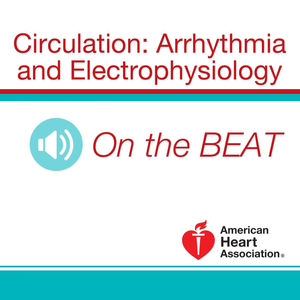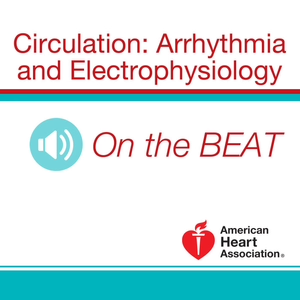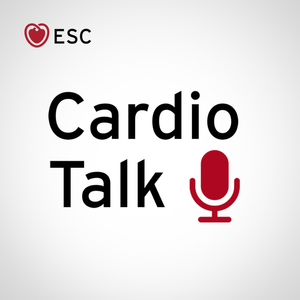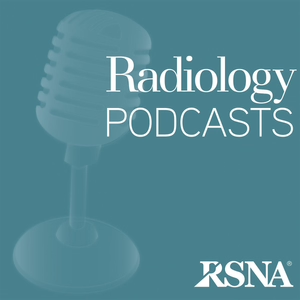
Circulation: Arrhythmia and Electrophysiology On the Beat May 2018
05/15/18 • 15 min
Paul Wang: Welcome to the monthly podcast, On the Beat, for Circulation: Arrhythmia and Electrophysiology. I'm Dr. Paul Wang, editor-in-chief, with some of the key highlights from this month's issue.
In our first study, Filip Plesinger and associates examined whether a computerized analysis of the body surface 12-lead ECG can be used to measure the ventricular electrical activation delay as a predictor of heart failure or death following resynchronization therapy in a MADIT-CRT trial.
The authors found that left bundle branch block patients with baseline ventricular electrical activation delay less than 31.2 milliseconds had a 35% risk of MADIT-CRT endpoints, while patients with ventricular electrical activation delay greater than or equal to 31.2 milliseconds had a 14% risk, P value of less than 0.001.
The hazard ratio for predicting primary endpoints in patients with low ventricular electrical activation delay was 2.34 with a P value of less than 0.01. However, ventricular electrical activation delay was not predicted in patients with right bundle branch block or IVCD.
In our next study, Karl-Heinz Kuck and associates examined the predictors of long-term clinical outcomes after catheter ablation of atrial fibrillation in 750 patients in the FIRE AND ICE Trial. Using propensity score stratification methods to count for differences in baseline characteristics between sexes, the authors found that female sex with a hazard ratio of 1.37, P equals 0.01, and prior direct current cardioversion with a hazard ratio of 1.40, P equals 0.013 were independently associated with atrial fibrillation recurrence.
Female sex with hazard ratio of 1.36, P value of 0.035 and hypertension with a hazard ratio of 1.48, P value of 0.013 independently predicted cardiovascular rehospitalization. A longer history of atrial fibrillation with a hazard ratio of 1.03, P value of 0.039 increased the rate of repeat ablation.
After propensity score adjustment, women continued to have higher rates of primary efficacy failure with adjusted hazard ratio of 1.51, P less than 0.05 and cardiovascular rehospitalization with a hazard ratio of 1.40, P less than 0.05.
In the next study, Laura Bear and associates examined the reliability of inverse electrocardiographic mapping of cardiac electrical activity from recorded body surface potentials. In five anesthetized closed-chest pigs, torso and ventricular epicardial potentials were recorded simultaneously during sinus rhythm, epicardial, and endocardial ventricular pacing. Two approaches, coupled finite/boundary element methods and a meshless approach based on the method of fundamental solutions, were compared.
The authors found that inverse mapping underestimated epicardial potentials more than twofold, P less than 0.0001. Mean correlation coefficients for reconstructed epicardial potential distributions ranged from 0.60 to 0.64 across all methods. Epicardial electrograms were recovered with reasonable fidelity at approximately 50% of the sites, but variation was substantial.
General activation spread was reproduced with a mean correlation coefficient of 0.72 to 0.78 for activation time maps with spatio-temporal smoothing. Epicardial foci were identified with a mean location error approximately 16 millimeters. Inverse mapping with method of fundamental solutions was better than coupled finite/boundary element methods.
The authors concluded that spatio-temporal variability of recovered electrograms may limit the resolution, with implications for accuracy of arrhythmia localization.
In the next study, Pejman Raeisi-Giglou and colleagues examined the incidence of pulmonary vein stenosis in 10,368 patients undergoing atrial fibrillation ablation from 2000 to 2015. Computed tomography scans were performed three to six months after the procedures. Severe pulmonary vein stenosis was observed in 52 patients, or 0.5%. The left superior pulmonary vein represented 51% of all severely stenosed veins.
Percutaneous interventions were performed in 43 patients, and complications occurred in five, including three pulmonary vein ruptures, one stroke and one phrenic injury. Over a median follow-up of 25 months, 41, or 79%, of patients remained arrhythmia-free.
In our next paper, Koichi Nagashima and associates compared hot balloon ablation and cryoballoon ablation in a 165 consecutive patients who underwent initial atrial fibrillation catheter ablation. Of the 165 patients, 74 propensity score-matched patients equally divided between hot balloon ablation and cryoballoon ablation were studied.
Patients' characteristics included age, sex, body mass index, atrial fibrillation subtype, CHA2DS2-VASc score, and left atrial dimension were similar between the two groups. 52% of the hot balloon ablation patients required touch-up with radiofrequency ablation for residual/dormant pulmonary vein condu...
Paul Wang: Welcome to the monthly podcast, On the Beat, for Circulation: Arrhythmia and Electrophysiology. I'm Dr. Paul Wang, editor-in-chief, with some of the key highlights from this month's issue.
In our first study, Filip Plesinger and associates examined whether a computerized analysis of the body surface 12-lead ECG can be used to measure the ventricular electrical activation delay as a predictor of heart failure or death following resynchronization therapy in a MADIT-CRT trial.
The authors found that left bundle branch block patients with baseline ventricular electrical activation delay less than 31.2 milliseconds had a 35% risk of MADIT-CRT endpoints, while patients with ventricular electrical activation delay greater than or equal to 31.2 milliseconds had a 14% risk, P value of less than 0.001.
The hazard ratio for predicting primary endpoints in patients with low ventricular electrical activation delay was 2.34 with a P value of less than 0.01. However, ventricular electrical activation delay was not predicted in patients with right bundle branch block or IVCD.
In our next study, Karl-Heinz Kuck and associates examined the predictors of long-term clinical outcomes after catheter ablation of atrial fibrillation in 750 patients in the FIRE AND ICE Trial. Using propensity score stratification methods to count for differences in baseline characteristics between sexes, the authors found that female sex with a hazard ratio of 1.37, P equals 0.01, and prior direct current cardioversion with a hazard ratio of 1.40, P equals 0.013 were independently associated with atrial fibrillation recurrence.
Female sex with hazard ratio of 1.36, P value of 0.035 and hypertension with a hazard ratio of 1.48, P value of 0.013 independently predicted cardiovascular rehospitalization. A longer history of atrial fibrillation with a hazard ratio of 1.03, P value of 0.039 increased the rate of repeat ablation.
After propensity score adjustment, women continued to have higher rates of primary efficacy failure with adjusted hazard ratio of 1.51, P less than 0.05 and cardiovascular rehospitalization with a hazard ratio of 1.40, P less than 0.05.
In the next study, Laura Bear and associates examined the reliability of inverse electrocardiographic mapping of cardiac electrical activity from recorded body surface potentials. In five anesthetized closed-chest pigs, torso and ventricular epicardial potentials were recorded simultaneously during sinus rhythm, epicardial, and endocardial ventricular pacing. Two approaches, coupled finite/boundary element methods and a meshless approach based on the method of fundamental solutions, were compared.
The authors found that inverse mapping underestimated epicardial potentials more than twofold, P less than 0.0001. Mean correlation coefficients for reconstructed epicardial potential distributions ranged from 0.60 to 0.64 across all methods. Epicardial electrograms were recovered with reasonable fidelity at approximately 50% of the sites, but variation was substantial.
General activation spread was reproduced with a mean correlation coefficient of 0.72 to 0.78 for activation time maps with spatio-temporal smoothing. Epicardial foci were identified with a mean location error approximately 16 millimeters. Inverse mapping with method of fundamental solutions was better than coupled finite/boundary element methods.
The authors concluded that spatio-temporal variability of recovered electrograms may limit the resolution, with implications for accuracy of arrhythmia localization.
In the next study, Pejman Raeisi-Giglou and colleagues examined the incidence of pulmonary vein stenosis in 10,368 patients undergoing atrial fibrillation ablation from 2000 to 2015. Computed tomography scans were performed three to six months after the procedures. Severe pulmonary vein stenosis was observed in 52 patients, or 0.5%. The left superior pulmonary vein represented 51% of all severely stenosed veins.
Percutaneous interventions were performed in 43 patients, and complications occurred in five, including three pulmonary vein ruptures, one stroke and one phrenic injury. Over a median follow-up of 25 months, 41, or 79%, of patients remained arrhythmia-free.
In our next paper, Koichi Nagashima and associates compared hot balloon ablation and cryoballoon ablation in a 165 consecutive patients who underwent initial atrial fibrillation catheter ablation. Of the 165 patients, 74 propensity score-matched patients equally divided between hot balloon ablation and cryoballoon ablation were studied.
Patients' characteristics included age, sex, body mass index, atrial fibrillation subtype, CHA2DS2-VASc score, and left atrial dimension were similar between the two groups. 52% of the hot balloon ablation patients required touch-up with radiofrequency ablation for residual/dormant pulmonary vein condu...
Previous Episode

Circulation: Arrhythmia and Electrophysiology On the Beat April 2018
Dr. Paul Wang: Welcome to the monthly podcast On the Beat for Circulation Arrhythmia and Electrophysiology. I'm Dr Paul Wang, editor-in-chief, with some of the key highlights for this month's issue. We'll also hear from Dr. Suraj Kapa reporting on new research from the latest journal articles in the field.
In our first article, Barry Maron associates report on the long term clinical course of hypertrophic cardiomyopathy patients following ICD therapy for ventricular arrhythmias. They studied a cohort of 486 high-risk hypertrophic cardiomyopathy patients with ICDs from eight international centers. Of these 486 patients over 6.4 years, 94 patients or 19% experienced appropriate ICD interventions, terminating VT or VF. Of the 94 patients receiving appropriate ICD therapy, 87 were asymptomatic or only mildly symptomatic at the time of appropriate ICD interventions. Of these 87 patients, 74 or 85% remained in classes one or two without significant change in clinical status of the subsequent 5.9 years up to 22 years. Among the 94 patients, there was one sudden death in three patients who died from non arrhythmic hypertrophic cardiomyopathy related processes. Post ICD intervention, freedom from hypertrophic cardiomyopathy, mortality was 100% at one year, 97% at five years, and 92% at 10 years, distinctly lower than the risk of ischemic or non ischemic cardiomyopathy in ICD trials.
Hypertrophic cardiomyopathy patients with ICDs interventions reported the heightened anxiety and expectation of future shocks. However, they did not affect general psychological well-being or quality of life. The authors concluded that in hypertrophic cardiomyopathy, unlike ischemic heart disease, prevention of sudden death with ICD therapies unassociated with a significant increase in cardiovascular morbidity and mortality, nor transformation into heart failure deterioration, ICD therapy does not substantially impair overall psychological and physical well-being. In our next article, Abdulla Damluji and associates examined the cost of hospitalizations for cardiac arrest using the US nationwide inpatient sample from 2003 to 2012. Using the log transformation of inflation adjusted costs the authors examined 1,387,396 patients who were hospitalized after cardiac arrest. They had a mean age of 66 years. Inpatient procedures included coronary angiography in 15%, PCI in 7%, intra-aortic balloon pump in 4.4%, therapeutic hypothermia in 1.1%, and mechanical circulatory support in 0.1% of patients.
Notably the rates of therapeutic hypothermia increased from 0 in 2003 to 2.7 in 2012, p less than 0.001. Both hospital charges inflation adjusted costs linear increased over time. In a multi-variant analysis predictors of inflation adjusted costs included large hospitals size, urban teaching hospital, and length of stay. Among co-morbidities, atrial fibrillation or fluid and electrolytes imbalance were the most common associated with cost. The authors found that during the period between 2003 and 2012 post cardiac arrest, hospitalizations had a steady rise and associated healthcare costs likely related to increase length of stay, medical procedures and systems of care.
In our next paper, Peter Huntjens and associates examined intrinsic interventricular dyssynchrony as a predictor of human dynamic response to cardiac resynchronization. The authors use a cardiovascular computational model CircAdapt to characterize the isolated effect of intrinsic interventricular or intraventricular activation on resynchronization therapy response that is the change in LV dP/dt max. The simulated change in LV dP to dt max had a range of 1.3 to 26.5% increased considerably with increasing inter ventricular dyssynchrony. In contrast, the isolated effect of intra ventricular dyssynchrony was limited with the change in the LV dP/dt max range and the left ventricle from 12.3 to 18.3% in the right ventricle from 14 to 15.7%.
Secondly, electrocardiographic imaging derived activation characteristics of 51 CRT candidates were used to create individual models of ventricular activation in CircAdapt. The model predicted change in LV dP/dt max was close to the actual value in left bundle branch block patients with 2.7% difference between measured and simulated when only intrinsic interventricular dyssynchrony was personalized. Among non left bundle branch block patients a change in LV dP/dt max was systematically over predicted by CircAdapt with a 9.2% difference between measured and simulated. Adding intra ventricular activation to the model did not improve the accuracy of response prediction. The authors found that computer revealed intrinsic interventricular dyssynchrony is the dominant component of the electrical substrate driving the response to CRT.
In the next paper Kenji Kuroki and associates examined the use of voltage limit adjustment of substrate mapping and fast Fourier transform analysis of local ventricular bipola...
Next Episode

Circulation: Arrhythmia and Electrophysiology On the Beat June 2018
Dr Paul Wang: Welcome to the monthly podcast, On the Beat, for Circulation: Arrhythmia and Electrophysiology. I'm Dr Paul Wang, editor-in-chief, with some of the key highlights from this month's issue.
Dr Paul Wang: In our first paper, Farhad Pashakhanloo and associates examine the three-dimensional structure of the healed infarct and the ventricular tachycardia reentrant pathways in high-resolution models of infarcted porcine hearts. The authors used ex vivo late gadolinium enhancement in diffusion tensor MRI data of eight chronically infarcted porcine hearts at sub-millimeter resolution in a novel scar map thickness metric to reveal the heterogeneous organization of infarct. The authors use simulation to model ventricular tachycardia pathways. They found that a surviving sub-endocardial tissue later of varying thickness less than or equal to 2.2 millimeters surrounding the scar participated in the majority of ventricular tachycardias. The authors concluded that these analyses provided a better understanding of infarc-related ventricular tachycardia.
Dr Paul Wang: In our next paper, Thomas Hadberg Lynge and associates studied the incidence of sudden cardiac death in a population of congenital heart disease in Denmark. Among 24.4 million person years over a nine-year period, there were 11,451 deaths that were examined. Of 809 cases of sudden cardiac death, 90, or 11% of the cases, were from congenital heart disease. Of these cases, 53, or 59% had the diagnosis of congenital heart disease prior to death. The incidence of sudden cardiac death was 9.6 times higher among patients with congenital heart disease compared to patients without congenital heart disease, p
If you like this episode you’ll love
Episode Comments
Generate a badge
Get a badge for your website that links back to this episode
<a href="https://goodpods.com/podcasts/circulation-arrhythmia-and-electrophysiology-on-the-beat-94401/circulation-arrhythmia-and-electrophysiology-on-the-beat-may-2018-5066096"> <img src="https://storage.googleapis.com/goodpods-images-bucket/badges/generic-badge-1.svg" alt="listen to circulation: arrhythmia and electrophysiology on the beat may 2018 on goodpods" style="width: 225px" /> </a>
Copy




